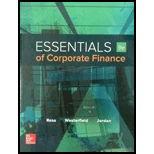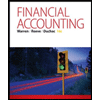
a)
To calculate: The shareholders’ equity for 2016 and 2015.
Introduction:
Cash flow refers to the difference between the cash that comes into the business and the cash that goes out of the business. The following are the different types of cash flows in a corporation:
- Cash flow from assets:
It refers to difference between the revenues from the sale of assets and the money invested in purchasing the assets.
- Cash flow to creditors:
It refers to the interest paid to the creditors minus the net fresh debt borrowed by the company.
- Cash flow to stockholders:
It refers to the dividend paid to the shareholders of the company minus the fresh equity raised by the company.
- Operating cash flow:
It refers to the cash flow from operating activities of the firm.
a)
Answer to Problem 22QP
The stockholders’ equity for 2015 is $7,273. The stockholders’ equity for 2016 is $6,311.
Explanation of Solution
Given information:
The current assets are $2,718, the net fixed assets are $12,602, the current liabilities are $1,174, and the long-term debt is $6,873 for the year 2015. The current assets are $2,881, the net fixed assets are $13,175, the current liabilities are $1,726, and the long-term debt is $8,019 for the year 2016.
Formulae:
Compute the total assets for 2015:
Hence, the total assets for 2015 is $15,320.
Compute the total liabilities for 2015:
Hence, the total liabilities for 2015 is $8,047.
Compute the stockholders’ equity for 2015:
Hence, the stockholders’ equity for 2015 is $7,273.
Compute the total assets for 2016:
Hence, the total assets for 2016 is $16,056.
Compute the total liabilities for 2016:
Hence, the total liabilities for 2016 is $9,745.
Compute the stockholders’ equity for 2016:
Hence, the stockholders’ equity for 2016 is $6,311.
b)
To calculate: The change in net working capital for 2016.
Introduction:
Cash flow refers to the difference between the cash that comes into the business and the cash that goes out of the business. The following are the different types of cash flows in a corporation:
- Cash flow from assets:
It refers to difference between the revenues from the sale of assets and the money invested in purchasing the assets.
- Cash flow to creditors:
It refers to the interest paid to the creditors minus the net fresh debt borrowed by the company.
- Cash flow to stockholders:
It refers to the dividend paid to the shareholders of the company minus the fresh equity raised by the company.
- Operating cash flow:
It refers to the cash flow from operating activities of the firm.
b)
Answer to Problem 22QP
The change in net working capital for 2016 is ($389).
Explanation of Solution
Given information:
The current assets are $2,718 and the current liabilities are $1,174for the year 2015. The current assets are $2,881 and the current liabilities are $1,726 for the year 2016.
Formulae:
Compute the ending net working capital:
Hence, the ending net working capital is $1,155.
Compute the beginning net working capital:
Hence, the beginning net working capital is $1,544.
Compute the change in net working capital:
Hence, the change in net working capital is ($389).
c)
To calculate: The cash flow from assets for 2016, and the fixed assets sold in 2016.
Introduction:
Cash flow refers to the difference between the cash that comes into the business and the cash that goes out of the business. The following are the different types of cash flows in a corporation:
- Cash flow from assets:
It refers to difference between the revenues from the sale of assets and the money invested in purchasing the assets.
- Cash flow to creditors:
It refers to the interest paid to the creditors minus the net fresh debt borrowed by the company.
- Cash flow to stockholders:
It refers to the dividend paid to the shareholders of the company minus the fresh equity raised by the company.
- Operating cash flow:
It refers to the cash flow from operating activities of the firm.
c)
Answer to Problem 22QP
The cash flow from assets is $10,239. The company sold $3,153 worth of fixed assets.
Explanation of Solution
Given information:
The company had sales of $40,664. The costs of goods sold were $20,393. The company charged $3,434 as
Formulae:
Compute the net income:
| Company P | ||
| Income statement | ||
| Particulars | Amount | Amount |
| Net sales | $40,664 | |
| Less: | ||
| Costs | $20,393 | |
| Depreciation | $3,434 | $23,827 |
| Earnings before interest and taxes | $16,837 | |
| Less: Interest paid | $938 | |
| Taxable income | $15,899 | |
| Less: Taxes ($15,899×40%) | $6,360 | |
| Net income | $9,539 | |
Hence, the net income is $9,539.
Compute the operating cash flow:
| Company Q | |
| Operating cash flow | |
| Particulars | Amount |
| Earnings before interest and taxes | $16,837 |
| Add: Depreciation | $3,434 |
| $20,271 | |
| Less: Taxes | $6,360 |
| Operating cash flow | $13,911 |
Hence, the operating cash flow is $13,911.
Compute the net capital spending:
| Company Q | |
| Net capital spending | |
| Particulars | Amount |
| Ending net fixed assets | $13,175 |
| Less: Beginning net fixed assets | $12,602 |
| $573 | |
| Add: Depreciation | $3,434 |
| Net capital spending | $4,007 |
Hence, the net capital spending is $4,007.
Compute the cash flow from assets:
The operating cash flow is $13,911. The change in net working capital is ($389), and the net capital spending is $4,007.
Hence, the cash flow from assets is $10,293.
Compute the fixed assets sold:
Hence, the value of fixed assets sold is $3,153.
d)
To calculate: The cash flow to creditors, and the amount of long-term debt paid off.
Introduction:
Cash flow refers to the difference between the cash that comes into the business and the cash that goes out of the business. The following are the different types of cash flows in a corporation:
- Cash flow from assets:
It refers to difference between the revenues from the sale of assets and the money invested in purchasing the assets.
- Cash flow to creditors:
It refers to the interest paid to the creditors minus the net fresh debt borrowed by the company.
- Cash flow to stockholders:
It refers to the dividend paid to the shareholders of the company minus the fresh equity raised by the company.
- Operating cash flow:
It refers to the cash flow from operating activities of the firm.
d)
Answer to Problem 22QP
The cash flow to creditors is ($208). The company paid off $1,009 worth of long-term debt.
Explanation of Solution
Given information:
The long-term debt is $6,873 for the year 2015, and the long-term debt is $8,019 for the year 2016. The raised $2,155 in new long-term debt. The company paid interest amounting to $938.
Formulae:
Compute the net new borrowing:
Hence, the net new borrowing is $1,146.
Compute the cash flow to creditors:
Hence, the cash flow to creditors is ($208).
Compute the debt paid off:
Hence, the value of debt paid off is $1,009.
Want to see more full solutions like this?
Chapter 2 Solutions
Essentials of Corporate Finance (Mcgraw-hill/Irwin Series in Finance, Insurance, and Real Estate)
- Need the WACC % WACC and Optimal Capital Structure F. Pierce Products Inc. is considering changing its capital structure. F. Pierce currently has no debt and no preferred stock, but it would like to add some debt to take advantage of the tax shield. Its investment banker has indicated that the pre-tax cost of debt under various possible capital structures would be as follows: Market Debt-to-Value Ratio (wd) Market Equity-to-Value Ratio (ws) Market Debt-toEquity Ratio (D/S) Before-Tax Cost ofDebt (rd) 0.0 1.0 0.00 6.0 % 0.10 0.90 0.1111 6.4 0.20 0.80 0.2500 7.0 0.30 0.70 0.4286 8.2 0.40 0.60 0.6667 10.0 F. Pierce uses the CAPM to estimate its cost of common equity, rs, and at the time of the analaysis the risk-free rate is 5%, the market risk premium is 7%, and the company's tax rate is 25%. F. Pierce estimates that its beta now (which is "unlevered" because it currently has no debt) is 1.4. Based on this information, what…arrow_forwardNed's Co. has an average collection period of 45 days and an operating cycle of 130 days. It has a policy of keeping at least $10 on hand as a minimum cash balance, and has a beginning cash balance for the first quarter of $20. Beginning receivables for the quarter amount to $35. Sales for the first and second quarters are expected to be $110 and $125, respectively, while purchases amount to 80% of the next quarter's forecast sales. The accounts payable period is 90 days. What are the cash disbursements for the first quarter? Question 4 options: $92 $88 $76 $100 $110arrow_forwardLiberal credit terms for customers is associated with a restrictive short-term financial policy. Question 3 options: True Falsearrow_forward
- An accounts payable period decrease would increase the length of a firm's cash cycle. Consider each in isolation. Question 6 options: True Falsearrow_forwardWhich of the following is the best definition of cash budget? Question 10 options: Costs that rise with increases in the level of investment in current assets. A forecast of cash receipts and disbursements for the next planning period. A secured short-term loan that involves either the assignment or factoring of the receivable. The time between sale of inventory and collection of the receivable. The time between receipt of inventory and payment for it.arrow_forwardShort-term financial decisions are typically defined to include cash inflows and outflows that occur within __ year(s) or less. Question 9 options: Four Two Three Five Onearrow_forward
- A national firm has sales of $575,000 and cost of goods sold of $368,000. At the beginning of the year, the inventory was $42,000. At the end of the year, the inventory balance was $45,000. What is the inventory turnover rate? Question 8 options: 8.46 times 13.22 times 43.14 times 12.78 times 28.56 timesarrow_forwardThe formula (Cash cycle + accounts payable period) correctly defines the operating cycle. Question 7 options: False Truearrow_forwardAn accounts payable period decrease would increase the length of a firm's cash cycle. Consider each in isolation. Question 6 options: True Falsearrow_forward
- Which of the following issues is/are NOT considered a part of short-term finance? Question 5 options: The amount of credit that should be extended to customers The firm determining whether to issue commercial paper or obtain a bank loan The amount of the firms current income that should be paid out as dividends The amount the firm should borrow short-term A reasonable level of cash for the firm to maintainarrow_forwardLiberal credit terms for customers is associated with a restrictive short-term financial policy. Question 3 options: True Falsearrow_forwardAn increase in fixed assets is a source of cash. Question 2 options: True Falsearrow_forward
 Financial Accounting: The Impact on Decision Make...AccountingISBN:9781305654174Author:Gary A. Porter, Curtis L. NortonPublisher:Cengage Learning
Financial Accounting: The Impact on Decision Make...AccountingISBN:9781305654174Author:Gary A. Porter, Curtis L. NortonPublisher:Cengage Learning Financial AccountingAccountingISBN:9781305088436Author:Carl Warren, Jim Reeve, Jonathan DuchacPublisher:Cengage Learning
Financial AccountingAccountingISBN:9781305088436Author:Carl Warren, Jim Reeve, Jonathan DuchacPublisher:Cengage Learning

